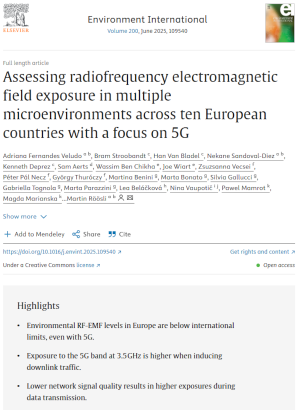5G radiation exposure below international safety limits – study across 10 European countries
11 June 2025
Environmental exposure to 5G radiofrequency electromagnetic fields (RF-EMF) remains below international safety limits, according to a major study across 10 European countries. The study, led by the Swiss Tropical and Public Health Institute with support from ARC West researchers, also found exposure varies by urbanicity, network quality and how the phone is used.
The researchers found the highest exposure takes place when uploading large amounts of data from a mobile phone. Environmental exposure from mobile phone base stations was typically higher in populated areas. Rural areas registered the highest exposure levels when the phone was continuously uploading data, due to a sparser mobile phone network.
The analysis is part of Project GOLIAT, a major European Union Horizon Europe funded programme led by ISGlobal in Barcelona, Spain. It provides the most comprehensive assessment to date of environmental and personal exposure to radiofrequency electromagnetic fields from 5G networks across 10 European countries. The results have been published in Environment International.
The study assessed exposure levels in over 800 different microenvironments — including schools, transport hubs, and residential areas — in both urban and rural settings across Austria, Belgium, France, Hungary, Italy, the Netherlands, Poland, Spain, Switzerland and the UK.
Using backpack-mounted RF exposimeters and mobile phones configured for different usage scenarios (non-use, maximum download, and maximum upload), researchers measured exposure across 35 frequency bands, including key 5G frequencies like 3.5 GHz. Measurements were taken between 2023 and 2024 under real-world conditions.
Environmental levels well below the limits
The first of the scenarios assessed was the non-user mode, in which the researchers’ phones were set in flight mode. With this method, the team assessed environmental exposure to RF-EMF, which in line with previous research, was found to be generally low and remained well below international guidelines.
Adriana Fernandes Veludo, first author of the study, said:
“We observed that in the non-use scenario exposure was lower in rural areas and tended to increase with urbanisation, something that can be attributed to a higher density of base stations in urban areas.”
The lowest environmental levels of exposure were registered in those countries with more stringent precautionary levels of RF-EMF, such as Switzerland, Belgium or Italy.
Higher levels when mobile phones are actively used
The data revealed that exposure to RF-EMF increased substantially when mobile phones were actively used.
In the scenario where mobile phones were set to download large files, exposure was -depending on the country – from 2 to 20 times higher than in the non-use scenario. This was because of emissions from the phone interacting with the base station.
Interestingly, the new 5G bands have been used only in some countries, reflecting country differences in the state of 5G implementation.
Lastly, the highest levels of exposure were registered in the maximum uplink scenario, where phones were set to upload large amounts of data and emitted about 30cm away from the measurement device. Compared to the non-use scenario, exposure levels were between 9 and 53 times higher, depending on the country. Those with the highest mean levels of exposure were the Netherlands, Italy and Belgium.
Martin Röosli, researcher at the Swiss TPH and last author of the study, said:
“Unlike in the non-use scenario, in the maximum data upload scenario the highest exposure levels were measured in rural areas, where the network signal quality is poorer and the phones need to emit at higher power to send the data.”
It is important to note that in the Netherlands and in Poland, 5G services in the 3.5 GHz frequency band were not yet in use at the time of the measurements, in 2023, and have only been launched in 2024.
The teams are now collecting new data to evaluate the evolution of 5G exposure levels in Europe.
Paper
